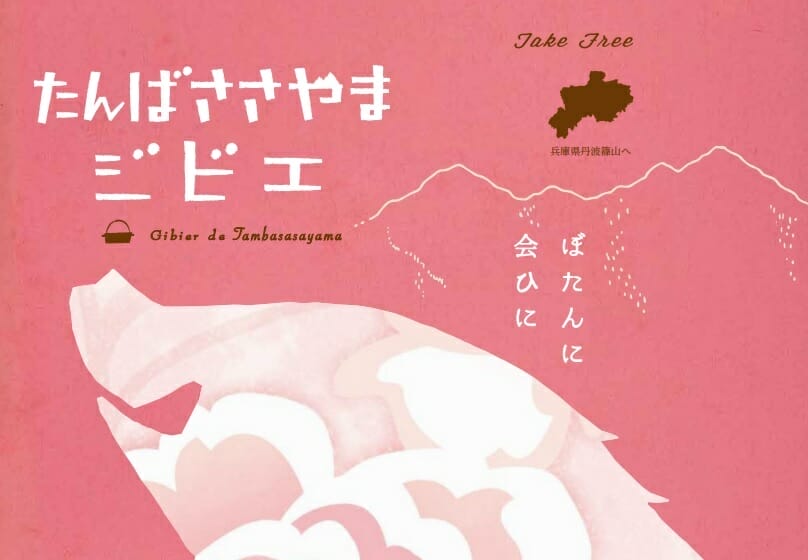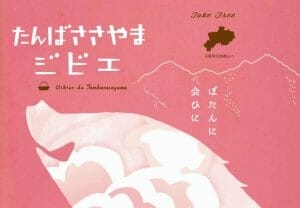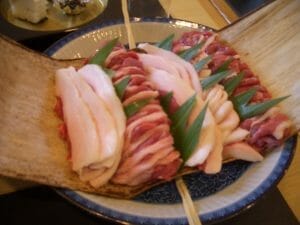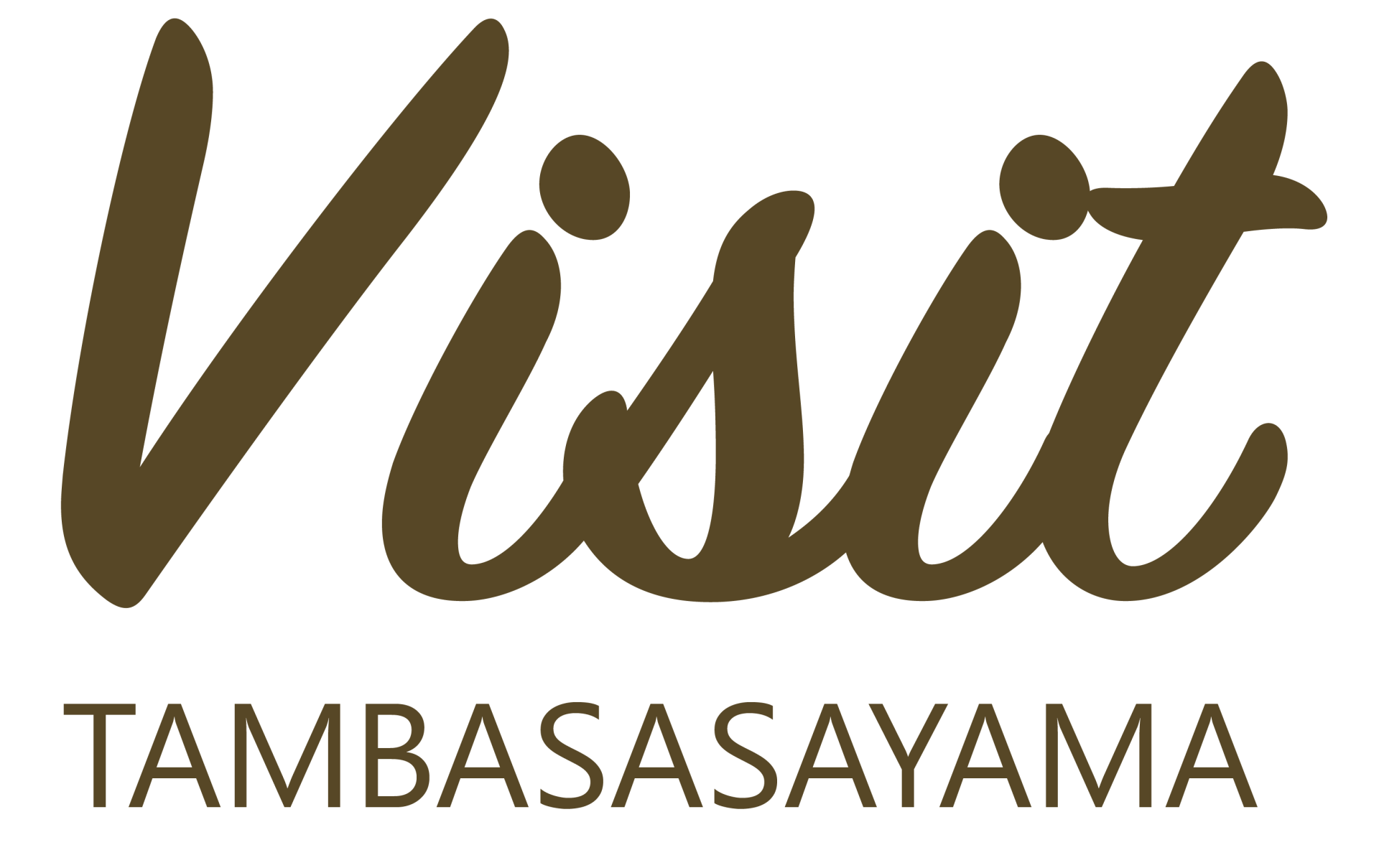Tambasasayama Botan nabe Guide

* Please see the PDF version of the latest Botan nabe guide.
(only in Japanese)

History of Botan Nabe
Wild boar meat has been eaten since Jomon period(8000BC – 2000BC). Even when Buddhism was introduced and meat eating was prohibited, it was called “mountain whale” and was eaten as a valuable protein source in rural satoyama.
In Edo period, people used to call different meat in different names. For example, boar meat was called ‘Botan’ or peony, horse meat has another name ‘Sakura’ or cherry, and deer meat ‘Momiji’ or maple.
When the Meiji era began and the ban on meat eating was lifted, the pot of wild boar meat cooked with miso was called “Ino-nabe”.
The wild boar meat of Tambasasayama became known all over the country around 1908, when the soldiers of the 70th Regiment of the Army Infantry Corps ate the wild boar meat in miso soup as a nourishing food. They used the wild boar caught in the mountains in Tambasasayama.
The soldiers couldn’t forget the taste, and when returned to their hometown, they spread the word, “The wild boar meat of Tambasasayama is very special!” Thus it became famous nationwide.

In 1931, the predecessor group of the Sasayama City Chamber of Commerce solicited the lyrics for the folk song “Sasayama Kouta”, and the word “Botan nabe” appeared for the first time in the fourth lyrics. In ‘Inonabe’ being four Japanese letter didn’t fit so good with the song, so the five-Japanese-letter word Botan Nabe was used.
Around 1945, a long-established local inn has begun to serve wild boar meat, which resembles a peony flower, according to the name “Botan nabe”. In this way, the name of Tambasasayama Botan nabe spread all over the country.
In 2007, it was selected as a representative dish of Hyogo Prefecture in the ‘100 Selections of Local Cuisine in Agriculture, Mountains and Fishing Villages’ sponsored by the Ministry of Agriculture, Forestry and Fisheries. Currently, about 40 stores offer Botan nabe in Tambasasayama City .
The cut of wild boar affects the price of Botan nabe!
The wild boar meat handled at the Tambasasayama store is not farmed, but natural wild boar!
They run around the mountains of Tambasasayama, eat nuts such as chestnuts, Tamba matsutake mushrooms, and grains. They put on only as much fat as they need to survive the winter. That is why it is not so greasy.
* Polyunsaturated fatty acids, which are abundant in wild boar meat, help reduce bad cholesterol and make thick blood thin.

* The standard amount of meat for one serving of Botan nabe is 150g-200g.
・ Loin is soft and light (good quality of fat, rare part).
・ Chuck has a rich flavor.
・ Belly has umami(the hidden fifth taste) and is the best taste of fat!
・ Back rib is a little tough but the more you chew on it the more taste comes out.
・ Picnic has the rich taste of red meat.
・ Leg has a good balance of red-white.
・ Thinly sliced meat has a reasonable price and suits for the home cooking.
Botan nabe with only the loin meat is very expensive, so if you would like to make the price reasonable, it is recommended to order with other parts.
We are particular about how to cut the meat!
Some shops are very particular about cutting the meat by hand.
Cutting by hand takes more time and effort than by machine. Also, cutting thinly and to a uniformed thickness takes experience and the ability of the person who cuts it is tested.
However, cutting by hand makes it possible to remove tendon and fat which is difficult with a machine. Also, because the chef can cut differently according to the meat, soft and easy-to-eat meat can be served.
Botan nabe served with a unique ‘dashi’
The northern part of Hyogo prefecture is famous for producing Sansho or Japanese pepper. Traditionally Botan nabe is cooked in miso and eaten with Japanese papper which gives you a tingling sensation on the tongue. That is still a typical way to enjoy Botan nabe, but recently new recipes are being created.
・ Blended miso
・ White miso
・ Warishita (soup stock with soy sauce, sugar, mirin, and sake mixed in)
・ Shirodashi (one of soy sauce varieties which is like white soy sauce with dashi flavor. It is sweeter and more savory than common one.)

What they have in common is their commitment to create their own dashi. It is a style that you can enjoy the co-starring of the dashi stock that the chef is proud of and the dashi stock that comes out of the wild boar meat. And if the dashi stock changes, the choice of the Shime*, or the last dish will also change. Enjoy various Botan nabe to suit your taste.
* Japanese usually put in starch to finish hot pot dishes such as udon, porridge, or rice with a soft-boiled egg.
この投稿をInstagramで見る
List of the store introduced in Tambasasayama Gibier booklet
| Registered store name | address | Contact information | ||
| 1 | Cooking inn Takasago | 6 Nikaimahi | +81-79-552-2158 | ・possible to have meal only (w/o staying) ・a little thick taste ・eat with beaten egg |
| 2 | Ryoriryokan Iketomi | 125 Tatimachi | +81-79-552-0064 | ・possible to have meal only (w/o staying) ・a little light taste ・hand-cut raw meat |
| 3 | Jinyourou | 79 Nikaimachi | +81-79-552-0021 | ・possible to have meal only (w/o staying) ・a little rich ・grilled boar meat |
| 4 | Tambasasayama Kinmata | 81 Nikaimachi | +81-79-552-2191 | ・The store where Botan nabe originated |
| 5 | Tambasasayama Local Cuisine, Kai | 58 Nikaimachi | +81-79-552-7773 | ・booking not required ・slightly light taste ・a specialty store |
| 6 | Sasayama Tamamizu | 148 Inuishinmachi | +81-79-552-0884 | ・reservation only ・moderate sweetness light ・parking available |
| 7 | JA Tambasasayama directly managed store Tokusan Kan Sasayama | 70-1 Kurooka | +81-79-552-3386 | ・booking not required ・White miso base ・one person hot pot set meal available |
| 8 | Morimoto-ya in Kusayama | 476-1 Kuwabara | +81-79-592-0123 | ・a little light sweet and rich ・homemade miso is also popular for take-out |
| 9 | Nyogetsu-an | 123 Kitashinmachi | +81-79-552-5200 | ・reservation required for dinner ・miso with chestnuts ・branch store: Botantei |
| 10 | Mountain village cuisine Maekawa | Tatsumachi 93 | +81-090-2065-4595 | Botan-nabe (wild boar hot pot) course meal
The hot pot is flavored with broth, not miso. |
| 11 | Wild boar restaurant Okuei | 492-5 Fujiokaoku | +81-79-552-4441 | ・a little light ・fresh meat all year round from the directly managed ranch |
| 12 | Ohte Shincho | 71 Nikaimachi | +81-79-554-2777 | ・booking not required ・a hot pot for one person available |
| 13 | Ishiyaki Kobo Season | 264 Sugi | +81-79-594-1888 | ・reservation required ・boar meat grilled on a natural stone plate is popular |
| 14 | Restaurant Sanmon | 116 Tokochi | +81-79-596-0820 | ・provide fresh raw meat ・also popular as the wild boar meat store |
| 15 | Ajidokoro Mitake | 683 Kurooka | +81-79-552-1385 | ・reservation required ・hot pot for one person available ・Saba(mackerel) sushi is also popular |
| 16 | Mantairo | Hioki 150 | +81-79-556-2021 | Reservation required Hand-cut raw meat is provided for the hot pot |
| 17 | Hanakoushi | 160 Kawaramachi | +81-79-552-2808 | ・reservation required ・modest sweetness ・White miso ・soba nuts porridge for shime |
| 18 | Shishigin, Sue no Sato store | 3 Kondacho Kamitachikui | +81-79-597-2173 | ・Shabu-shabu with rich white dashi. ・using only 3-year-old female wild boar |
| 19 | Zensho Tannan Saryo | 92-4 Ajimashin | +81-79-590-1020 | ・reservation required ・sukiyaki style with Warishita ・grilled wild boar |
| 20 | Morimotoya | 441 Miyata | +81-79-593-0004 | Enjoy with sushi |
| 21 | Tamba Sasayama Ikkyuan | 78-2 Yamauchicho | +81-79-552-0279 | Enjoy with soba |
| 22 | Satoyama Kobo Kumobe | Nishihonjo Nishinoyama 2-1 | +81-79-556-2570 | A cafe utilizing a closed school A one-person hotpot is available |
| 23 | Honke Kumanoen | 456 Ajimaoku | +81-79-594-0162 | Enjoy with Tamba tea |
| 24 | Hanapara | 52-1 Ajimashin | +81-79-590-1187 | Enjoy with various dishes |
| 25 | Ryorisha Yamayu | Agake 81 | +81-79-590-1261 | Enjoy with Tororo (grated yam) |
| 26 | Hogyoen | 52 Kawakitashinden | +81-79-593-1341 | Enjoy with fish |
| 27 | Tambasasayama Matsukazeya | 95 Higashikosa | +81-79-594-5454 | ・reservation required ・blended miso ・local chicken dishes are also popular |
| 28 | Uo Sei | 56-1 Hioki | +81-79-556-2052 | Enjoy with fish |
| 29 | Tamagawarou | 32 Gofukucho | +81-79-554-2266 | Enjoy with various dishes |
| 30 | Konda Yakushi Onsen Nukumori no Sato | 21-10 Kondashinden, Kondacho | +81-79-590-3377 | ・Konda Yakushi Onsen ・possible to have meal only (w/o bathing) ・bathing ticket gift |
| 31 | Yu no Tsubo | 79 Shitsukawa Shinden | +81-79-556-3685 | ・Kagobo Onsen ・possible to have meal only (w/o staying) ・White miso-based soup |
| 32 | Tamba Inomura | 1154 Shitsukawa | +81-79-556-2680 | ・athletics course available ・accommodation and camping are possible |
| 33 | Unitopia Sasayama | 231-1 Yashiro | +81-79-552-5222 | ・possible to have meal only (w/o staying) ・One-day hot springs available ・Popular with children |
| 34 | Lodge S ・ P ・ H | 956-1 Higashibuki | +81-79-594-2093 | ・possible to have meal only (w/o staying) ・Sukiyaki / Shabu-shabu available ・Inokotsu soup(wild boar bone broth) |
| 35 | Umetan FUJI | Ofuji 65-3 | +81-90-8450-8602 | An inn that is popular for its game meat cuisine.
Meals without staying overnight are available. |
| 36 | Holonpia Hotel | 76-4 Nakano | +81-79-594-2611 | ・modest sweetness ・a little light ・local orange Chinese cabbage used |
| 37 | Shin Tambaso | 451-4 Gunge | +81-79-552-3111 | ・possible to have meal only (w/o staying) ・reservation required ・One-day hot spring available |

